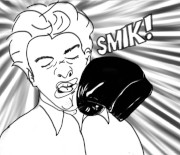|
I'm confused on capitalization on cars and such. I know it's Ford, but is it cortina or Cortina? As in "She got in her cortina." or w/e. Only capitals with 'Ford Cortina'?
|
|
|
|

|
| # ? May 20, 2024 22:10 |
|
Fat Jesus posted:I'm confused on capitalization on cars and such. I know it's Ford, but is it cortina or Cortina? As in "She got in her cortina." or w/e. Only capitals with 'Ford Cortina'? If it's a name, you capitalize it. A Cortina is a name.
|
|
|
|
In the distant future, all trucks are called bronks.
|
|
|
|
Wungus posted:If it's a name, you capitalize it. A Cortina is a name. Specifically, "Ford" is the name of the Brand, often called a Marque or the 'Make.' Brands are usually (but not always) named after a division of the auto company. Brands each have Platforms - essentially common chassis on which multiple car lines are built (but these are almost never referred to unless you're in the auto industry, but that's why some cars look so much like others e.g. Camaros and Firebirds). A Line, also called a Model, is the name of the car, like Camry, Wrangler, Prius, etc. After that there are Trim levels which are pre-set options which usually divide the line into luxury and powertrain options, and may have names themselves (SE, Limited, etc.). Finally, there are Styles, which also sometimes have a designation such as 4WD, 4x4, etc.. Can you tell I worked in the auto industry for a while? The reason I typed this out, is because all the things above have proper Names with a capital N and they go like the below. Other common names and designations you may see are usually not capitalized (2-door vs 4-door, convertible, off-road etc.) Year / Make / Model / Trim / Style / ------------------------------------------------------------ 2014 / Jeep / Liberty / Sport / 4WD 2003 / Jeep / Wrangler / Rubicon / Tomb Raider Edition 1967 / Corvette / Stingray / / / 1970 / Ford / Thunderbird / / / 1967 / Cadillac / Coupe de Ville / / / convertible
|
|
|
|
Just wanted to pop by and say that falling into a groove and gliding to quintuple my daily writing target is an extraordinary experience. I should post in this thread. It seems useful. Skippy McPants fucked around with this message at 19:39 on Jul 6, 2023 |
|
|
|
About the car names, I was leaning to capitals but remembered some vague thing about some things being so common you can use lowercase now, trust me, in 1985 Cortina's were everywhere and I've seen it spelt both ways.General Battuta posted:In the distant future, all trucks are called bronks. Don't stop there.
|
|
|
|
That’s more like kleenex or xerox or bandaid. E: If I wrote, “In the afternoon I saw an impala in front of my house.” I think that might confuse people. Doctor Zero fucked around with this message at 18:43 on Jul 8, 2023 |
|
|
sebmojo posted:chatgpt is free, you can try for yourself! this is coherent, it's very bland and not what I'd call good but it's a story. One thing that I feel have gotten lost in the debate is that ChatGPT isn't just for generating text from nothing. It can also be used to analyze existing texts, which I find far more interesting as a potential writing tool. In the following, I have simply pasted the Father John story above into ChatGPT and written command prompts below. Prompt posted:Summarize the story in a list of bullet points. Reponse posted:* Father John, burdened by doubts and a wavering faith, finds himself struggling with his calling as a priest. Prompt posted:Identify usages of passive voice and suggest rewrites to active voice. Reponse posted:1. "The weight of his doubts was pressing upon his weary shoulders." Prompt posted:Analyze the story using the plot beats from Save The Cat. Reponse posted:"Save the Cat" is a popular screenwriting methodology that outlines key plot beats commonly found in successful stories. While the given story doesn't precisely follow the structure of "Save the Cat," we can still identify some elements that align with its principles. Here's an analysis of the story using the essential plot beats of "Save the Cat": Of course, such suggestions should be taken with a huge grain of salt, but the same could be said for writing tools such as Grammerly and Hemingway App, which also make plenty of stupid suggestions. The point is to draw your attention to things you wouldn't otherwise have noticed. I don't see why this should be considered any more controversial than using existing writing tools to find awkward sentences, etc. ChatGPT can only take about 4000 words at the moment, so you can't do this with stories, but I am still having a lot fun experimenting with it. SimonChris fucked around with this message at 16:35 on Jul 12, 2023 |
|
|
|
|
SimonChris posted:Passive voice Only the last two are actually passive voice, lol.
|
|
|
|
ActingPower posted:Only the last two are actually passive voice, lol. 5 is passive, and 7 is better analysed as an adjective if you ask me, but we don't need to nitpick, because... None of those "quotations" are in the story. 1, 2, 3, 4, 6, and 8 aren't quite right, mostly because parts of sentences are being described as whole sentences. 5 is a passive version of an active voice sentence in the story, and 7 is adapted from two other sentences. Lol at "Bless me, Father, for I have sinned", too. E: The first summary is also wrong in at least two places. Can't be bothered to do the Save the Cat! one. Safety Biscuits fucked around with this message at 16:50 on Jul 12, 2023 |
|
|
|
Haha, yeah, I probably should have checked the original story myself before I posted that. Still, it is fun to play with. Edit: I don't see the issues with the summary, though. Every point on the list matches something that happens in the story. The Save the Cat skips two of the beats but also references actual events from the story. It is not just making things up in this case. SimonChris fucked around with this message at 13:12 on Jul 13, 2023 |
|
|
|
|
 This is a good object lesson in what ChatGPT can and can't do. It can match a style, that's a pattern in the data. It can hear the sound of a list, so it can reproduce the structure, down to subtle things like how entries in a list should be similar-sounding but distinct. It can't actually process the information, but It's so good at matching patterns that it can guess correctly because seen it said so many times before. It doesn't know passive tense and active tense, but it does know that when someone says "passive tense" and then writes a sentence with passive tense in it, the next line is the same except some words are switched. Or in the summary, it doesn't know how to summarize a story, but it knows how to sound like it's summarizing a story. This is a good object lesson in what ChatGPT can and can't do. It can match a style, that's a pattern in the data. It can hear the sound of a list, so it can reproduce the structure, down to subtle things like how entries in a list should be similar-sounding but distinct. It can't actually process the information, but It's so good at matching patterns that it can guess correctly because seen it said so many times before. It doesn't know passive tense and active tense, but it does know that when someone says "passive tense" and then writes a sentence with passive tense in it, the next line is the same except some words are switched. Or in the summary, it doesn't know how to summarize a story, but it knows how to sound like it's summarizing a story.If you need a good reminder of how much info neural nets will invent, just think of Greg Obama. 
Djeser fucked around with this message at 08:02 on Jul 13, 2023 |
|
|
|
Roger Penrose is right, going to need quantum computers light years ahead of what we have.
|
|
|
|
Safety Biscuits posted:E: The first summary is also wrong in at least two places. Can't be bothered to do the Save the Cat! one. The Save the Cat analysis is pretty forced. STC is really designed for 120-minute movies, so it talks about B-plots and C-plots, which don't actually happen in a short story. Also it's better-suited to stories with explicit human antagonists, as opposed to inner turmoil.
|
|
|
|
SimonChris posted:Edit: I don't see the issues with the summary, though. Every point on the list matches something that happens in the story. The Save the Cat skips two of the beats but also references actual events from the story. It is not just making things up in this case. I was thinking of these two: quote:He finds solace in his decision and uses his experiences to help others in need, guided by his own convictions. The first one is in the story; I messed up, oops. But the second is a mistake because Father John left the priesthood earlier in the story; it's reading the concluding/summarising final paragraph of the story as narration. Which is a pretty impressive kind of failure, to be fair.
|
|
|
|
Chat GPT will do grammar checking, but Word is better TBQH. The best use of "AI" I've found so far is Eleven Labs voice AI to read your work back to you. I catch things I miss by reading my own work, even reading it out loud to myself. Plus you can make cool celebrity voices and have Sir David Attenborough or Tom Hiddleston read your stuff to you.
|
|
|
|
Doctor Zero posted:Chat GPT will do grammar checking, but Word is better TBQH. A word of warning. If you put your writing into AI it will be stolen and used to feed the algorithm. I recommend against this.
|
|
|
|
Also there's a hell of a lot of actors who really don't want you to pirate their fuckin' voices and a major deal with the current SAG/AFTRA strikes is actors not wanting their likeness to be ripped off by training an AI to replicate them. Or fuckin' do what you want I guess
|
|
|
|
The man returned to his chair on the edge of the room, and looked at the blank book, and tried to think what he would write in it. The blank pages were in themselves simple and complete. But there must be some simple words, within his reach, with which to throw further light. He would have liked to write some poem or prayer in the empty book, and for some time did consider that idea, remembering the plays of Shakespeare that he had read lying on his stomach as a boy, but any words that came to him were the stiff words of a half-forgotten literature that had no relationship with himself. — Patrick White, The Tree of Man
|
|
|
|
Fat Jesus posted:The man returned to his chair on the edge of the room, and looked at the blank book, and tried to think what he would write in it. The blank pages were in themselves simple and complete. But there must be some simple words, within his reach, with which to throw further light. He would have liked to write some poem or prayer in the empty book, and for some time did consider that idea, remembering the plays of Shakespeare that he had read lying on his stomach as a boy, but any words that came to him were the stiff words of a half-forgotten literature that had no relationship with himself. *frantically trying to turn on my monitor*
|
|
|
|
I saw something that cracked open my brain with regards to the whole 'overexplaining/meticulously detailed magic systems' discussion had a few... months back? but only a few pages back in this thread. Also it's funny. 
|
|
|
|
Junpei posted:I saw something that cracked open my brain with regards to the whole 'overexplaining/meticulously detailed magic systems' discussion had a few... months back? but only a few pages back in this thread. That is valid but I feel that at the same time, one might want to have at least a base knowledge of combustion engines and telecommunication networks -- much like we should -- so that cars don't regularly make ridiculous jumps and drive away or people don't slap their hands over a keyboard for a few minutes and then say "I'm in" while hacking. With loads of good information literally being at our fingertips we shouldn't perpetuate ignorance regardless if we're talking common magic (technology) or fantasy magic (alien technology)
|
|
|
|
Fair enough, I'm not saying never discuss your magic systems at all, just that there should be a midpoint.
|
|
|
|
The telephone rang. Jason Wilkins roused himself out of his dough-and-flour-addled stupor, and gazed at the ringing noise emanating from the receiver. He was tall, even for an American, this despite his father’s very average height and his mother’s petite build. Some had suggested – in hushed tones and never to his face, of course – that it was because his mother had long ago taken an … interest in the very tall mailman who’d graced their neighborhood mail delivery route for so many years. Mail delivery was one of those necessary evils of modern American life; a citizen could send his friends and colleagues e-mail faxes that arrived in the blink of an eye, but there was always the reactionary old contingent who’d never wanted to bother with these “modern contraptions” who insisted on writing letters on paper and sending them through the antiquated network of delivery trucks and post offices, and so long as this contingent existed the mail would also have to exist. The telephone rang again. Jason wanted to groan and roll his eyes, but he suppressed this urge and put on the mask of outward neutrality expected of a Pizza Maker Second Class. He’d graduated from the Pizza Making Academy with high honors, learning all the nuances of flavor balance, oven management, and paddle flipping – not to mention the highly prized art of crust spinning – that went into any Pizza Maker in the service. But he’d also learned the importance of Customer relations, and of the need to project a combined air of confidence and deportment whenever he answered the phone. He slapped the flour dust from his hands, grasped the receiver, and placed it next to his ear. The light codes on the telephone’s front panel danced from flashing red to solid green, letting him know that a live connection had been established. “Pizza Barn,” he intoned. “Is this for dine in, pick up, or delivery?” “Before we begin,” the deep, resonant voice on the other end of the line said, “Let me thank you for taking the time out of your schedule to talk to me.” Of course, Jason knew, this appearance of graciousness was just a formality. Any Pizza Maker who’d ever received a call from a Customer knew that you made time for them, rain or shine, day or night, when the call came in. “I know many of you must be concerned about the latest announcements from the U.S. Department of Labor,” the voice continued, “Which underscore the slower-than-expected growth our domestic economy has experienced over the last Fiscal quarter. Let me assure you that I in no way intend to withhold and funds from the unwritten custom of tipping that has become so prevalent in your industry.” Inwardly, Jason breathed a sigh of relief. Tipping was the custom of paying extra – usually a percentage of the price paid for goods and services rendered – as a reward for outstanding service on the part of the service provider. At least, this was how the custom had gotten started. In practice, the custom had spread to the point where now a tip was expected even if merely average-quality service was provided. A man who transported a freshly-made pizza from the production facility to the Customer’s residence could usually count on receiving 15 percent of the pizza’s price as free money he could keep for himself, in addition to the salary paid him by his employer. As a result, employers typically took advantage of this situation and set their deliverers’ salaries artificially low. Since, technically, there was no legal requirement for the Customer to pay the tip, Customers who had fallen on hard economic times had been known to simply not pay it, leaving the delivery man barely able to subsist on the paltry wages his employer provided. Jason knew the co-worker who was assigned to delivery duty tonight, Pizza Delivery Person Third Class Alonzo Gomez, and had seen the despondent look on his face more than once when Alonzo had returned after a delivery without a tip in his pocket. But this customer had just given his assurance that he would be tipping, thereby relieving Jason of the worries he harbored for his co-worker and comrade. “As to your original question,” the voice on the phone resumed their conversation, “Of the three options you’ve offered to me, I think Delivery would be the most prudent at this juncture.” “All right,” Jason replied, maintaining his professional calm, “What’s your address?” “One two seven one five Harboraz Street,” the voice answered. “That’s Harboraz spelled like Harbor with an A-Z on the end.” “Is there an apartment number?” Jason asked. Although most Americans preferred to live in single-family units, there were many who, either through economic difficulty or a desire to live close by other specific individuals or simply not caring for the investment a single-family unit entailed, ended up living in large complexes of dewllings called apartments. Some apartment complexes towered dozens of stories high, a feat that would have been impossible in a pre-Bessemer civilization that lacked the ability to mass-manufacture steel. Others sprawled along the ground only a story or two high. But whatever size the complex was, it was always important to indentify which of the many individual units within that apartment complex one lived in. This was usually accomplished by a number, molded in metal and affixed to the center of the unit’s front door. Even the antiquated mail delivery system still relied on apartment numbers to route letters to the appropriate box when delivering mail to an apartment complex. “No,” the voice replied immediately, “No apartment number.” “What’s the nearest cross street?” Jason continued. In truth, his software would be able to tell him exactly where 12715 Harboraz Street was, and even the exact course that Alonzo could follow in his delivery vehicle to get him there in the least possible time. Modern delivery vehicles were the pinnacle of safety and comfort, but their basic design had changed little from the Model T that had seen service a century ago. An engine produced power by combusting air with gasoline vapor inside a cylinder, which drove a piston attached to a crankshaft. This spinning shaft provided torque that could be routed to the vehicle’s wheels through a series of shafts and gears. The wheels themselves mounted inflated rubber rings that pushed against the road surface and impelled the vehicle forward – or provided braking force if the driver chose to slow down. The contact between the wheels and the road, however, intimately depended on the planet’s gravity, and as such each vehicle was restricted to operating entirely on the surface of the planet. This meant that special roadways had had to be built throughout every city, roadways big enough and smooth enough to allow vehicles to pass. The route any driver took to his destination consisted of a series of turns, as these streets often intersected one another, creating a situation where vehicles following along one street had to be careful not to collide with vehicles following a street that crossed theirs. This series of successive turns could easily be figured out by modern map software – a feat that just three decades earlier would have seemed like science fiction – but there was always that tiny, tiny chance that the software would make a mistake, or that the street name in question might have been misspelled, and in that case it was vitally important that the driver have the name of another street nearby that ran perpendicular to the street he was interested in. “The cross street,” the voice resumed as though a dissertation on the history of urban traffic had not at all intervened, “Is 4th Avenue.” Jason dutifully wrote this latest piece of information down on a note pad he’d had sitting next to the phone for exactly this purpose. He followed the practice his manager had suggested weeks earlier and wrote in ink, using a hand-held ball-point ink pen made by the Paper Mate company that lay at the end of a tether next to the phone. Ink had had a long and proud history, dating back almost to the dawn of writing itself. He mused about the long, tortuous road leading from the first accountants’ tally marks in ancient Mesopotamia to the sophisticated symbolic system of writing modern Americans now enjoyed, but pushed that thought aside to maintain the proper professional air of aloof concentration that Customer relations required. Then, mentally, he braced himself for the next stage of the phone conversation. He knew it was coming, knew it was as inevitable as next morning’s rise of the G2 primary his planet orbited at a comfortable 8 light-minutes, but still he viewed it with trepidation, as he did every time a call got to this stage. “And,” he began, smoothing every edge out of his voice he didn’t intend to project, “What would you like?” “Well,” the voice answered, “I have in my hand a coupon, bearing the imprint of Pizza Barn and the telephone number I’m now calling you at.” Inwardly, Jason winced. Coupons were another of those necessary evils that had the potential to make the job of the Pizza Maker a living hell. They enticed a Customer to order goods or services when he wouldn’t otherwise be inclined to do so, by offering special pricing incentives that would expire if not used by the printed time limit. They also served as a kind of advertising for the company that printed them. However, the pricing deals they spelled out were often convoluted combinations that required the simultaneous ordering of multiple products, and more often than not the exact wording of those combinations appeared only on the coupon itself, copies of which were not made available at the production site – meaning the Pizza Maker answering the phone had no way of verifying the validity of the Customer’s interpretation of the coupon while taking his order. Jason recalled the many times a Customer had presented him with the coupon he’d discussed while making a telephone order, only to discover that the deal was different than the one the Customer had quoted or that the coupon had expired a week ago. In those circumstances, making the Customer happy could, and often did, become an exercise in futility. “This coupon,” the voice on the phone continued, “Allows me to purchase two medium-sized one-topping pizzas, and receive the second one at half price, so long as the second pizza is of equal or lesser value to the first.” Thank goodness, Jason thought. This coupon he recognized from a Pizza Barn flyer that had been mailed to his own residence earlier this week. The flyer had not been addressed to him by name, but had come addressed only to “Current resident” at his address. It was common for local businesses to send out copies of their advertising, such as coupon flyers, to every address known to exist in the city. The mail delivery service even provided bulk discounts to businesses who wanted to send out such “junk mail,” provided the businesses who wanted them sent took to the task of sorting the advertisements by destination address to make the job easier for the mail delivery personnel. By happenstance, Jason – an employee of Pizza Barn and in fact a Pizza Maker Second Class, no less – had received one of Pizza Barn’s own flyers. He’d scanned the coupons, filing their deals and their expiration dates away in his memory for future reference, and the second-medium-pizza-half-price deal his Customer had just quoted matched his memory exactly. “All right,” Jason said, “What would you like on your first pizza?” “Make the first pizza a mushroom pizza,” the voice answered. Jason wrote down a shorthand notation for “mushrooms” on the notepad, indicating that this topping belonged to the first pizza. He had already written down another shorthand, indicating that the pizza should be medium-sized. Although an Italian invention, modern pizza had flourished under the auspices of Americans like the Shakey Brothers, who had thrown caution to the wind and piled high the mozarella cheese that had so sparsely graced the earlier varieties. The earliest pizzas were little more than focaccia bread, and the notion of piling on pick-and-choose toppings would have been absurd to pizza’s pioneers. But today, topping selections had exploded, and included such wanton vagaries as pineapple, pesto, artichoke hearts, and the barbecued meat of poultry birds. Compared to such eccentric modern toppings, mushrooms almost seemed … quaint. “And the second?” he asked. “Make the second pizza with pepperoni,” the voice said, “And put it on thin crust.” For an instant, the color drained from Jason’s face and his blood ran cold. Had he actually said thin crust?! Thin crust was one of Pizza Barn’s top secret R&D projects. They had spent months coming up with the ideal balance of crust thickness, edge crimping, and the cornmeal base below the crust designed to reduce its traction on the paddle, all to address the desires of those customers who preferred less breadlike material below their toppings. They intended to release an announcement about Thin Crust over the television faxes, timed to be broadcast to every home during the Big Game, when the greatest number of viewers would be watching. But the Big Game wasn’t until next Sunday. How had this Customer learned of the existence of Thin Crust? Was he a spy for a rival pizza company? Had he merely heard rumors about thin crust, perhaps from unscrupulous Pizza Barn employees who’d leaked the secret, and was testing the water, trying to see how he would react? Jason would have to tread very, very carefully. “I’m sorry,” he began, “We don’t --” he suppressed the urge to say currently – “have thin crust available as an option.” “Oh,” the voice replied, and Jason could detect just a hint of crestfallenness in the tone of that single syllable. Jason wondered, briefly, whether he was disappointed that his ploy to get confidential information out of him had failed, or whether he … just had a thing for thin crust. “In that case, just put it on regular crust.” “Will that be all?” Jason asked. “Yes,” the voice answered. And now, the calculation began. The pricing of pizza was more art that science, primarily since each individual pizza was so eminently customizable. At base, the order consisted of two medium pizzas. Nominally, each medium pizza cost 10.95 U.S. dollars, but that was the base price and only included the crust, the sauce, and a standard-sized layer of mozarella cheese. What this customer had ordered were one-topping pizzas, pizzas which, in addition to the crust, sauce, and cheese, also each carried a custom topping that would be placed on top of the cheese just before the pizza entered the baking oven. His first pizza added mushrooms, which Jason noted – looking up the topping and pizza size on his pricing table – would increase its price by 0.75 U.S. dollars. His second pizza added pepperoni, perhaps the most popular of all pizza toppings, and looking this up in the same table showed an identical price increase for a medium pizza of the same 0.75 U.S. dollars. That raised the price of each pizza to … he punched the numbers into a tabletop calculator … 11.70 U.S. dollars. But this was before he factored the coupon into the price. The coupon ordained that whichever one of these pizzas had the lesser normal price would have its price cut in half. Since both pizzas clocked in at 11.70 dollars, either one could be used as the “lesser priced” pizza. Jason chose the pepperoni pizza, the second one the Customer had ordered, and cut its price in half. 11.70 divided by 2 was 5.85. Adding this 5.85 figure to the 11.70 normal price for the mushroom pizza resulted in a total bill of … 17.55 U.S. dollars. Or rather, it resulted in a sub-total of 17.55 U.S. dollars. The government of the state in which this Pizza Barn was located was always looking for ways to fill its own coffers, to pay for social programs that kept the politicians-in-power popular with the voters, and one of the ways it had chosen to do so was to impose a sales tax. For every sale that a vendor made to a Customer, the vendor had to pay a flat 5.75% of the sales price to the state’s tax collectors. However, a loophole in the law – engineered by a crafty coalition of vendors when the sales tax had first been voted on in the Legislature – allowed the vendor to charge the Customer with paying the sales tax directly into the vendor’s pockets. That loophole now meant that Jason had the responsibility of calculating the sales tax on the 17.55 U.S. dollar subtotal, and adding it to the Customer’s bill. He punched “+ 5.75%” into his calculator, and… “Your total with tax comes to eighteen fifty-six,” Jason said. “It should arrive in about …” he checked his chrono “… thirty to forty minutes.” “I’ll be waiting,” the voice said ominously, and closed the connection.
|
|
|
|
sebmojo posted:
Joke like that makes me think you should explain how its not the Queens English they are speaking. Harbour or Harbor? I think Brandon Sanderson did a good comparison on explaining magic vs not. Essentially Lord of the Rings doesn't explain magic, cause its.. magic. While with Sanderson, he wanted the reader to be able to piece together how the protagnist was going to "win" in fights, so the explains the magic system in depth.
|
|
|
|
DropTheAnvil posted:Joke like that makes me think you should explain how its not the Queens English they are speaking. Harbour or Harbor? i just read shards of earth and tchaikovsky's kind of a shocker for this kind of 'as you know professor' explanation. tolerable book, a bit like hamilton but without the cheese/horny
|
|
|
|
Currently reading Judith Merril’s England Swings SF from 1968, and it’s got a “story” in there that’s just a scenario of a professor’s computer breaking. That’s it. A bunch of Pythonesque twits standing about going “oh look the light’s blinking” “and now it’s not” “oh dear it’s smoking…” And ended with the professor giving up computers forever I suppose that was something back when computers were still novel and fairly rare but lol
|
|
|
|
DropTheAnvil posted:Joke like that makes me think you should explain how its not the Queens English they are speaking. Harbour or Harbor? Yet Lord of the Rings does clearly explain everything, almost exhaustively so, because Tolkien wanted to know everything about his subcreation. Just for some mysterious reason his explanations don’t register with a certain type of reader as “real” because they’re not couched as fictional physics. Tolkien understood that magic in a fantasy story is not just part of the world in a diegetic sense but also part of the story itself, part of the action of providence and eucatastrophe in shaping what happens. When the Witch-King confronts Gandalf and challenges him (“do you not know death when you see it”), and Gandalf is “saved” by the crowing of the cock and the arrival of Rohan, the reason Gandalf “wins” the “fight” should be glaringly obvious to anyone paying attention. But because nobody throws a fireball or casts Turn Undead as a level 30 paladin people somehow don’t parse it as “hard magic”, when if anything what’s going on is far more strongly determined than any Baldur’s Gate skirmish. I wish Sanderson had never opened his mouth about magic, it has wasted so much time in so many minds. He’s just saying “I want to write fair play mysteries but magic” which is a much better thing to say than “I don’t understand Tolkien and I’m going to make it everyone’s problem.”
|
|
|
|
The device used to take pizzas, and other baked goods, out of ovens is called a peel not a paddle.
|
|
|
|
Gaius Marius posted:The device used to take pizzas, and other baked goods, out of ovens is called a peel not a paddle. Invented by James Peel, who orange peel is named after, interestingly
|
|
|
General Battuta posted:Yet Lord of the Rings does clearly explain everything, almost exhaustively so, because Tolkien wanted to know everything about his subcreation. Just for some mysterious reason his explanations don’t register with a certain type of reader as “real” because they’re not couched as fictional physics. I wonder how much of this can be laid at the feet of D&D. Basically its whole gimmick was to turn Tolkien's "magic" system (and all related fantasy battle mechanics) into a numeric model, and ever since then we've been mired in POWER LEVEL OVER 9000!!! and JRPG leveling-up modes of thinking, which Jordan and Sanderson seem not to want to extricate themselves from because hey, it's what the readers want apparently. e: D&D players also aren't typically in it for the lessons in moral rectitude, which is what would anchor their fantasy physics in phenomena like providence and eucatastrophe and sacrifice and rejection of temptation and winning a battle because you're a good person Tabletop gamers are famously all about the nuts and bolts and numbers and rules Data Graham fucked around with this message at 14:53 on Jul 27, 2023 |
|
|
|
|
It may also be relevant that in Tolkien there are very few magic wielders, and the few we see are supporting characters. Whereas in most modern fantasy the core cast are always magic wielders, and you can't blindfoldedly throw a rock without hitting one. I wouldn't categorize it as a bad thing, though. A lot of readers are in fact there for the magic. Sanderson's Scrooge McDuck swimming pool full of money speaks for itself.
|
|
|
|
They absolutely are, and I’m mostly glad Sanderson makes a ton of money as he probably helps pay my advances! My irritation is not with the existence of his books or the choices he makes in writing them but in the way his (erroneous) description of his art vs. other art has confused the conversation.
|
|
|
|
sebmojo posted:The telephone rang.  
|
|
|
|
I don’t get it, why did you post the opening to Snow Crash
|
|
|
|
I mean that's what Jean Auel does for Stone Age civilisation and for some reason I find those almost addictively readable.
|
|
|
|
It just sounds kind of silly for things we're already intimately familiar with. Though on the other end of the spectrum, you get that apocryphal Polish dictionary definition: Horse: Everyone knows what a horse is.
|
|
|
|
HopperUK posted:I mean that's what Jean Auel does for Stone Age civilisation and for some reason I find those almost addictively readable. I have such good memories of spending my summer reading these when I was like 10 - 12, but in like the third book I would start skipping the landscape descriptions because they went on for paaaaaages
|
|
|
|
is it a bad thing to use italics, bolds and underlines? Because that's a thing I've noticed in a lot of published novels, they don't use it a lot unless they're, say, delineating an in-universe document from character's commenting on it, or the like.
|
|
|
|

|
| # ? May 20, 2024 22:10 |
|
In 'normal' narrative - narration and dialogue, no excerpts of documents - you never use bold or underline, and italics only sometimes for emphasis.
|
|
|






























